BMW X3 (F25) Owners Manual: Wheels and tires
Vehicle features and options
This chapter describes all standard, country-specific and optional features offered with the series. It also describes features that are not necessarily available in your car, e. g., due to the selected options or country versions. This also applies to safety-related functions and systems. The respectively applicable country provisions must be observed when using the respective features and systems.
- Tire inflation pressure
- Tire identification marks
- Tire tread
- Tire damage
- Changing wheels and tires
- Run-flat tires
- Mobility System
- Snow chains
Tire inflation pressure
Safety information
The tire characteristics and tire inflation pressure influence the following:
- The service life of the tires.
- Road safety.
- Driving comfort.
Checking the tire inflation pressure
Check the tire inflation pressure regularly
Regularly check the tire inflation pressure, and correct it as needed: at least twice a month and before a long trip. If you fail to observe this precaution, you may be driving on tires with incorrect tire pressures, a condition that may not only compromise your vehicle's driving stability, but also lead to tire damage and the risk of an accident.
Tires have a natural, consistent loss of tire inflation pressure.
Tires heat up while driving, and the tire inflation pressure increases along with the tire's temperature. The tire inflation pressure specifications relate to cold tires or tires with the ambient temperature.
Only check the tire inflation pressure when the tires are cold. This means after driving no more than 1.25 miles/2 km or when the vehicle has been parked for at least 2 hours.
The displays of inflation devices may underread by up to 1.45 psi/0.1 bar.
For Flat Tire Monitor: after correcting the tire inflation pressure, reinitialize the Flat Tire Monitor.
For Tire Pressure Monitor: after correcting the tire inflation pressure, reset the Tire Pressure Monitor.
Tire inflation pressure specifications
The tire inflation pressure table, contains all tire inflation pressure specifications for the specified tire sizes at the ambient temperature. Tire inflation pressure specifications apply to approved tire sizes and recommended tire brands. This information can be obtained from your service center.
To identify the correct tire inflation pressure, please note the following:
- Tire sizes of your vehicle.
- Maximum permitted driving speed.
Tire inflation pressures up to 100 mph/160 km/h
For speeds of up to 100 mph/160 km/h and for optimum driving comfort, note the pressure values in the tire inflation pressure table, and adjust as necessary.
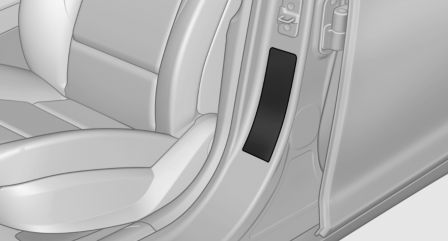
These pressure values can also be found on the tire inflation pressure label on the driver's door pillar.
Maximum permissible speed
Do not exceed 100 mph/160 km/h; otherwise, tire damage and accidents may result.
Tire inflation pressure values up to 100 mph/160 km/h
X3 sDrive28i, X3 xDrive28i, X3 xDrive28d
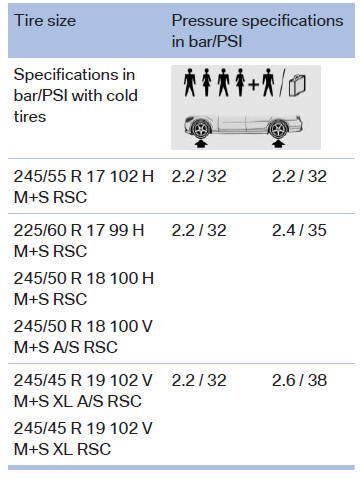
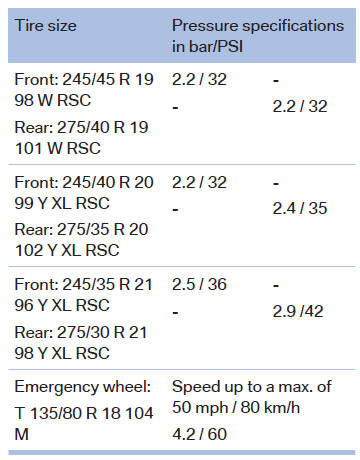
X3 xDrive35i
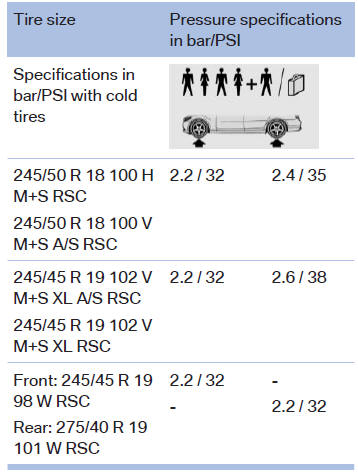
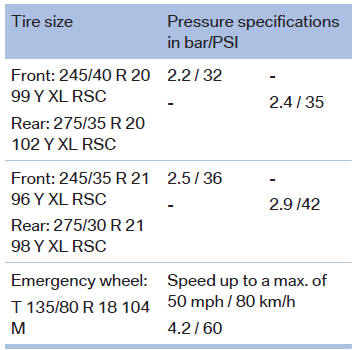
Tire inflation pressures at max. speeds above 100 mph/160 km/h
Speeds above 100 mph/160 km/h
In order to drive at maximum speeds in excess of 100 mph/160 km/h, please observe, and, if necessary, adjust tire pressures for speeds exceeding 100 mph/160 km/h from the relevant table on the following pages. Otherwise tire damage and accidents could occur.
Tire inflation pressure values over 100 mph/160 km/h
X3 sDrive28i, X3 xDrive28i, X3 xDrive28d
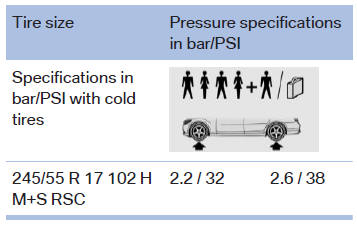
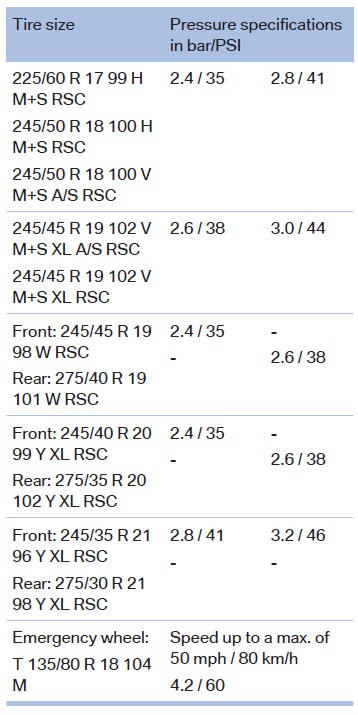
X3 xDrive35i
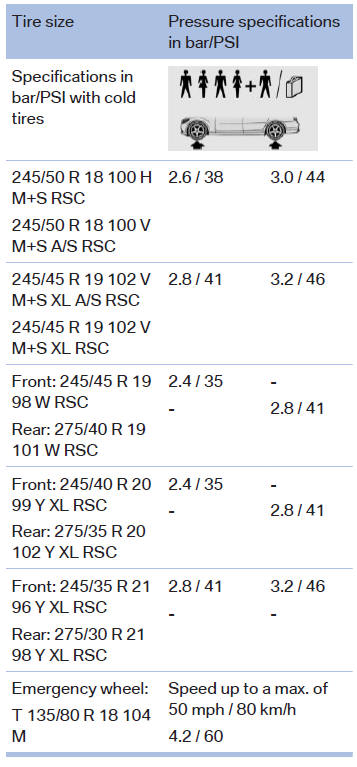
Tire identification marks
Tire size
245/45 R 18 96 Y
245: nominal width in mm
45: aspect ratio in %
R: radial tire code
18: rim diameter in inches
96: load rating, not for ZR tires
Y: speed rating, before the R on ZR tires
Speed letter
Q = up to 100 mph, 160 km/h
R = up to 106 mph, 170 km/h
S = up to 112 mph, 180 km/h
T = up to 118 mph, 190 km/h
H = up to 131 mph, 210 km/h
V = up to 150 mph, 240 km/h
W = up to 167 mph, 270 km/h
Y = up to 186 mph, 300 km/h
Tire Identification Number
DOT code: DOT xxxx xxx 0115
xxxx: manufacturer code for the tire brand
xxx: tire size and tire design
0115: tire age
Tires with DOT codes meet the guidelines of
the U.S. Department of Transportation.
Tire age
DOT ... 0115: the tire was manufactured in the 1st week of 2015.
Recommendation Regardless of wear and tear, replace tires at least every 6 years.
Uniform Tire Quality Grading
Quality grades can be found where applicable on the tire sidewall between tread shoulder and maximum section width.
For example: Treadwear 200; Traction AA; Temperature A
DOT Quality Grades
Treadwear
Traction AA A B C
Temperature A B C
All passenger car tires must conform to Federal Safety Requirements in addition to these grades.
Treadwear
The treadwear grade is a comparative rating based on the wear rate of the tire when tested under controlled conditions on a specified government test course. For example, a tire graded 150 would wear one and one-half, 1 g, times as well on the government course as a tire graded 100. The relative performance of tires depends upon the actual conditions of their use, however, and may depart significantly from the norm due to variations in driving habits, service practices and differences in road characteristics and climate.
Traction
The traction grades, from highest to lowest, are AA, A, B, and C.
Those grades represent the tire's ability to stop on wet pavement as measured under controlled conditions on specified government test surfaces of asphalt and concrete. A tire marked C may have poor traction performance.
The traction grade assigned to this tire is based on straight-ahead braking traction tests, and does not include acceleration, cornering, hydroplaning, or peak traction characteristics.
Temperature
The temperature grades are A, the highest, B, and C, representing the tire's resistance to the generation of heat and its ability to dissipate heat when tested under controlled conditions on a specified indoor laboratory test wheel.
Sustained high temperature can cause the material of the tire to degenerate and reduce tire life, and excessive temperature can lead to sudden tire failure. The grade C corresponds to a level of performance which all passenger car tires must meet under the Federal Motor Vehicle Safety Standard No. 109. Grades Band A represent higher levels of performance on the laboratory test wheel than the minimum required by law.
Temperature grade for this tire
The temperature grade for this tire is established for a tire that is properly inflated and not overloaded. Excessive speed, underinflation, or excessive loading, either separately or in combination, can cause heat buildup and possible tire failure.
If necessary, have the vehicle towed.
RSC - Run-flat tires
Run-flat tires, are labeled with a circular symbol containing the letters RSC marked on the sidewall.
M+S
Winter and all-season tires with better cold weather performance than summer tires.
Tire tread
Summer tires
Do not drive with a tire tread depth of less than 0.12 in/3 mm.
There is an increased danger of hydroplaning if the tire tread depth is less than 0.12 in/3 mm.
Winter tires
Do not drive with a tire tread depth of less than 0.16 in/4 mm.
Below a tread depth of 0.16 in/4 mm, tires are less suitable for winter operation.
Minimum tread depth
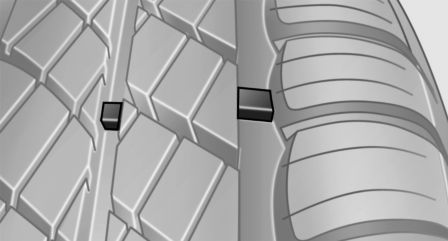
Wear indicators are distributed around the tire's circumference and have the legally required minimum height of 0.063 in/1.6 mm.
They are marked on the side of the tire with TWI, Tread Wear Indicator.
Tire damage
General information
Inspect your tires often for damage, foreign objects lodged in the tread, and tread wear.
Hints
Driving over rough or damaged road surfaces, as well as debris, curbs and other obstacles can cause serious damage to wheels, tires and suspension parts. This is more likely to occur with low-profile tires, which provide less cushioning between the wheel and the road. Be careful to avoid road hazards and reduce your speed, especially if your vehicle is equipped with low-profile tires.
Indications of tire damage or other vehicle defects:
- Unusual vibrations while driving.
- Unusual handling such as a strong tendency to pull to the left or right.
Damage can, e. g., be caused by driving over curbs, road damage, or similar things.
In case of tire damage
If there are indications of tire damage, reduce your speed immediately and have the rims and tires checked right away; otherwise, there is the increased risk of an accident.
Drive carefully to the nearest service center. If necessary, have the vehicle towed or transported there. Otherwise, tire damage can become life threatening for vehicle occupants and also other traffic.
Repair of tire damage
For safety reasons, the manufacturer of your vehicle recommends that you do not have damaged tires repaired; they should be replaced.
Otherwise, damage can occur as a result.
Changing wheels and tires
Mounting
Information on mounting tires
Have mounting and balancing performed only by a service center.
If work is not carried out properly, there is a danger of subsequent damage and related safety hazards.
Wheel and tire combination
You can ask the service center about the right wheel/tire combination and wheel rim versions for the vehicle.
Incorrect wheel and tire combinations impair the function of a variety of systems such as ABS or DSC.
To maintain good handling and vehicle response, use only tires with a single tread configuration from a single manufacturer.
Following tire damage, have the original wheel and tire combination remounted on the vehicle as soon as possible.
Approved wheels and tires
You should only use wheels and tires that have been approved by the vehicle manufacturer for your vehicle type; otherwise, e.g., despite having the same official size ratings, variations can lead to chassis contact and with it, the risk of severe accidents The manufacturer of your vehicle cannot evaluate non-approved wheels and tires to determine if they are suited for use, and therefore cannot guarantee the operating safety of the vehicle.
Recommended tire brands
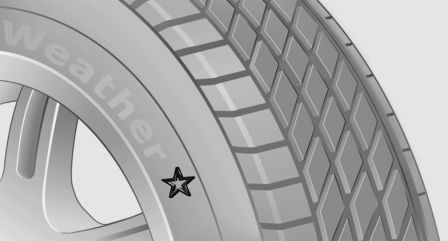
For each tire size, the manufacturer of your vehicle recommends certain tire brands. These can be identified by a star on the tire sidewall.
With proper use, these tires meet the highest standards for safety and handling.
New tires
Tire traction is not optimal due to manufacturing circumstances when tires are brand-new; they achieve their full traction potential after a break-in time.
Drive conservatively for the first 200 miles/300 km.
Retreaded tires
The manufacturer of your vehicle does not recommend the use of retreaded tires.
Retreaded tires
Possibly substantial variations in the design and age of the tire casing structures can limit service life and have a negative impact on road safety.
Winter tires
Winter tires are recommended for operating on winter roads.
Although so-called all-season M+S tires provide better winter traction than summer tires, they do not provide the same level of performance as winter tires.
Maximum speed of winter tires If the maximum speed of the vehicle is higher than the permissible speed for the winter tires, then a respective symbol is displayed in your field of vision. You can obtain this sign from the tire specialist or from your service center.
Maximum speed for winter tires
Do not exceed the maximum speed for the respective winter tires; otherwise, tire damage and accidents can occur.
Run-flat tires
If you are already using run-flat tires, for your own safety you should replace them only with the same kind. No spare tire is available in the case of a flat tire. Your service center will be glad to advise you.
Rotating wheels between axles
Different wear patterns can occur on the front and rear axles depending on individual driving conditions. The tires can be rotated between the axles to achieve even wear. Your service center will be glad to advise you. After rotating, check the tire pressure and correct if needed.
Rotating the tires is not permissible on vehicles with different tire sizes or rim sizes on the front and rear axles.
Storage
Store wheels and tires in a cool, dry place with as little exposure to light as possible.
Always protect tires against all contact with oil, grease and fuels.
Do not exceed the maximum tire inflation pressure indicated on the side wall of the tire.
Run-flat tires
Label
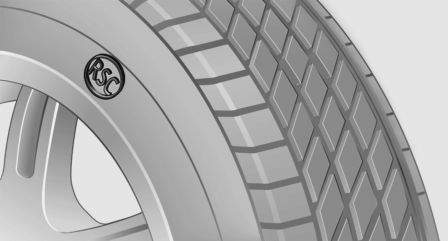
RSC label on the tire sidewall.
The wheels consist of tires that are self-supporting, to a limited degree, and possibly special rims.
The support of the sidewall allows the tire to remain drivable to a restricted degree in the event of a tire inflation pressure loss.
Follow the instructions for continued driving with a flat tire.
Changing run-flat tires
For your own safety, only use run-flat tires. No spare tire is available in the case of a flat tire.
Your service center will be glad to advise you.
Mobility System
The concept
With the Mobility System, minor tire damage can be sealed quickly to enable continued travel. To accomplish this, sealant is pumped into the tires, which seals the damage from the inside.
The compressor can be used to check the tire inflation pressure.
Hints
- Follow the instructions on using the Mobility System found on the compressor and sealant container.
- Use of the Mobility System may be ineffective if the tire puncture measures approx. 1/8 in/4 mm or more.
- Contact the nearest service center if the tire cannot be made drivable.
- If possible, do not remove foreign bodies that have penetrated the tire.
- Pull the speed limit sticker off the sealant container and apply it to the steering wheel.
- The use of a sealant can damage the TPM wheel electronics. In this case, have the electronics checked at the next opportunity and have them replaced if needed.
Enclosed areas
Do not let the engine run in enclosed areas, since breathing in exhaust fumes may lead to loss of consciousness and death. The exhaust gases contain carbon monoxide, an odorless and colorless but highly toxic gas.
Storage
The Mobility System is located under the cargo floor panel.
Sealing container
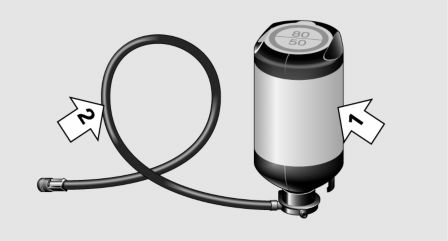
- Sealing container, arrow 1.
- Filling hose, arrow 2.
Observe use-by date on the sealant container.
Compressor
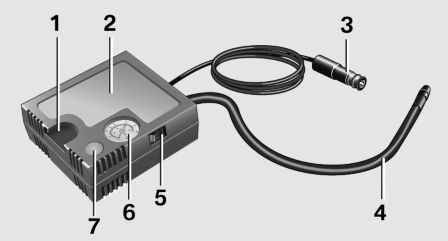
- Holder for bottle
- Compressor
- Connector/cable for socket
- Connection hose
- On/off reel
- Inflation pressure dial
- Reduce inflation pressure
Filling the tire with sealant
1. Shake the sealing container.
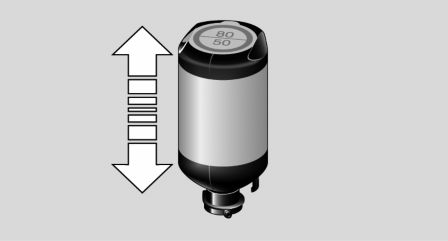
2. Pull the connection hose fully out of the compressor housing. Do not kink the hose.
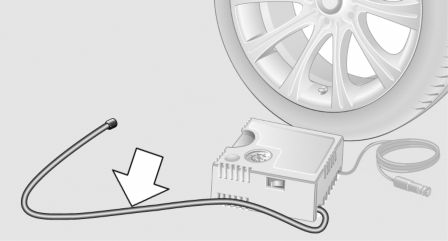
3. Screw the connection hose onto the connector of the sealant container.
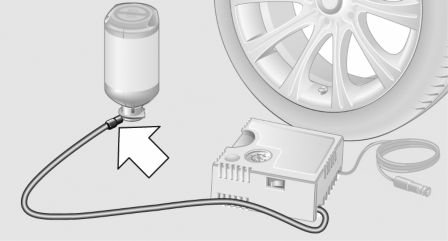
4. Insert the sealant container on the compressor housing in an upright position.
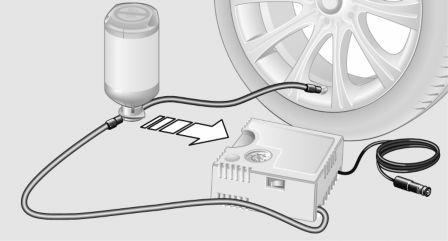
5. Screw the filling hose of the sealant container onto the tire valve of the defective wheel.
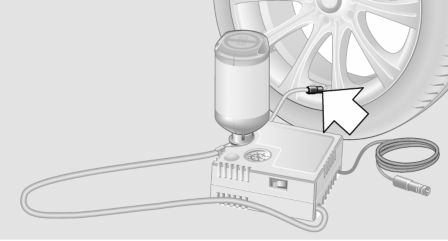
6. With the compressor switched off, insert the plug into the power socket inside the vehicle.
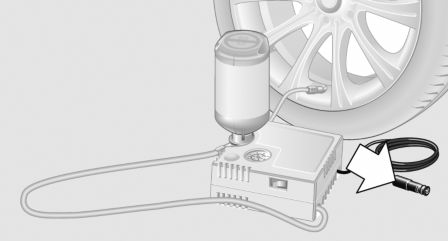
7. With the ignition turned on or the engine running, reel on the compressor.
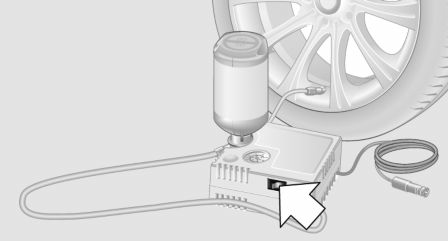
Switch off the compressor after 10 minutes
Do not allow the compressor to run longer than 10 minutes; otherwise, the device will overheat and may be damaged.
Let the compressor run for approx. 3 to 8 minutes to fill the tire with sealant and achieve a tire inflation pressure of approx. 2.5 bar.
While the tire is being filled with sealant, the tire inflation pressure may sporadically reach approx. 5 bar. Do not reel off the compressor at this point.
If a tire inflation pressure of 2 bar is not reached:
1. Switch off the compressor.
2. Unscrew the filling hose from the wheel.
3. Drive 33 ft/10 m forward and back to distribute the sealant in the tire.
4. Inflate the tire again using the compressor.
If a tire inflation pressure of 2 bar cannot be reached, contact your service center.
Stowing the Mobility System
1. Unscrew the filling hose of the sealant container from the wheel.
2. Unscrew the connection hose of the compressor from the sealant container.
3. Connect the filling hose of the sealant container previously connected to the tire valve with the available connector on the sealant container.
This prevents leftover sealant from escaping from the container.
4. Wrap the empty sealant container in suitable material to avoid dirtying the cargo area.
5. Stow the Mobility System back in the vehicle.
Distributing the sealant
Immediately drive approx. 5 miles/10 km to ensure that the sealant is evenly distributed in the tire.
Do not exceed a speed of 50 mph/80 km/h.
If possible, do not drive at speeds less than 12 mph/20 km/h.
To correct the tire inflation pressure
1. Stop at a suitable location.
2. Screw the connection hose of the compressor directly onto the tire valve stem.
3. Insert the connector into the power socket inside the vehicle.
4. Correct the tire inflation pressure to 2.5 bar.
- Increase pressure: with the ignition turned on or the engine running, reel on the compressor.
- To reduce the pressure: press the button on the compressor.
Continuing the trip
Do not exceed the maximum permissible speed of 50 mph/80 km/h.
Reinitialize the Flat Tire Monitor.
Reinitialize the Tire Pressure Monitor.
Replace the defective tire and the sealant container of the Mobility System as soon as possible.
Snow chains
Fine-link snow chains
Only certain types of fine-link snow chains have been tested by the manufacturer of the vehicle, classified as road-safe and approved.
Information about the approved snow chains are available from the service center.
Use
Use only in pairs on the rear wheels, equipped with the tires of the following size:
- 205/65 R 17.
- 225/60 R 17.
- 245/50 R 18.
- 245/45 R 19.
No snow chains on size 245/55 R 17 tires
Do not mount snow chains on size 245/55 R 17 tires; otherwise, the vehicle may become damaged.
Follow the snow chain manufacturer's instructions.
Make sure that the snow chains are always sufficiently tight. Retighten as needed according to the chain manufacturer's instructions.
Do not initialize the Flat Tire Monitor after mounting snow chains, as doing so may result in incorrect readings.
Do not initialize the Tire Pressure Monitor after mounting snow chains, as doing so may result in incorrect readings.
When driving with snow chains, briefly activate Dynamic Traction Control if needed.
Maximum speed with snow chains
Do not exceed a speed of 30 mph/50 km/h when using snow chains.
 Fuel
Fuel
Vehicle features and options
This chapter describes all standard, country-specific
and optional features offered with the
series. It also describes ...
 Engine compartment
Engine compartment
Vehicle features and options
This chapter describes all standard, country-specific
and optional features offered with the
series. It also describes ...
Other materials:
BMW X3 (F25) Service & Repair Manual > Suspension: Front axle suspension
REMOVING AND INSTALLING/REPLACING FRONT UNDERBODY PROTECTION
NOTE:
Illustration only an example. Detail deviations, depending on engine version,
are possible.
Unfasten screws (2).
Remove front underbody protection (1).
REMOVING AND INSTALLING/REPLACING REAR UNDERBODY PROTECTION
NOTE:
Sch ...
